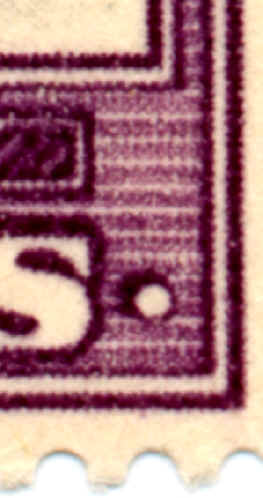| Photogravure is a direct image
gravure printing process where the image is etched into a plate using a photographic
process. This process involves screening the image which produces rows of cells which make
up the image. You always have a cell, so straight lines are made up of a row of dots
(cells). Because the ink involved with the gravure process is less dense and more a
liquid, the ink tends to fill in solid areas (These solid areas are really made up of
large cells, close together). The edges of designs using this process are not distinct.
You can see in the photo that everything, including the text, is made up
from small cells or dots. Looking closely at the illustration, you will see these
dots/cells along the edges of lines on the stamp. You can not have a perfectly
straight line in Photogravure, although some modern screens are very fine, making this
screening very difficult to see. |

|
| The design of a stamp to be printed
by Photogravure usually is photographed through a very fine screen. The screen
breaks up the subject into tiny dots which are then etched into the plate. The
depressions formed from this process hold the ink. The paper comes in contact with
the plate and the ink is lifted from the plate onto the paper. This is very similar
to Intaglio, except that there is little or no raised feeling to the ink because of the
very thin layer of ink. Photogravure is generally used for
multi-colored stamps and utilizes four basic ink colors: magenta, yellow, cyan and
black. A separate plate, which had previously been prepared by photographically
separating the colors, is required for each color.
Electronic engraving using computer generated screens is now used on
many modern stamps, so these stamps may not show some of these characteristics. |